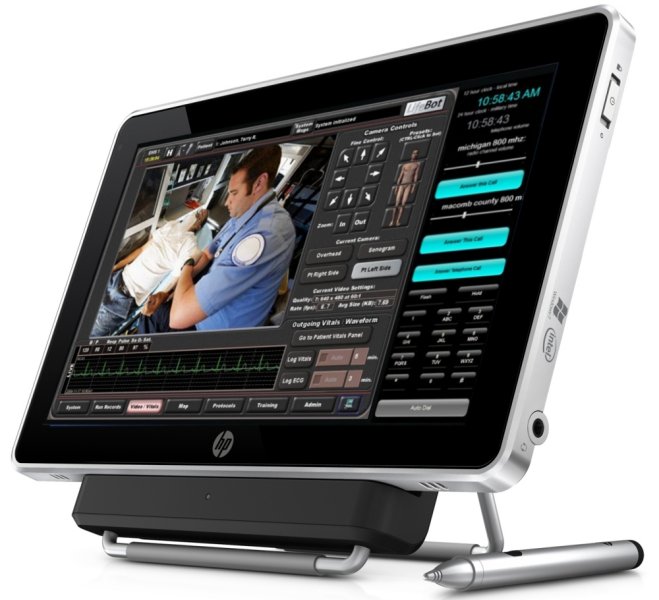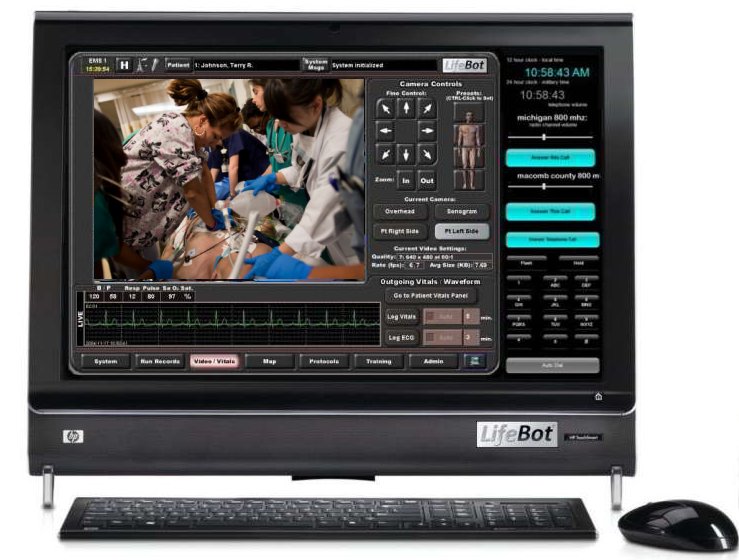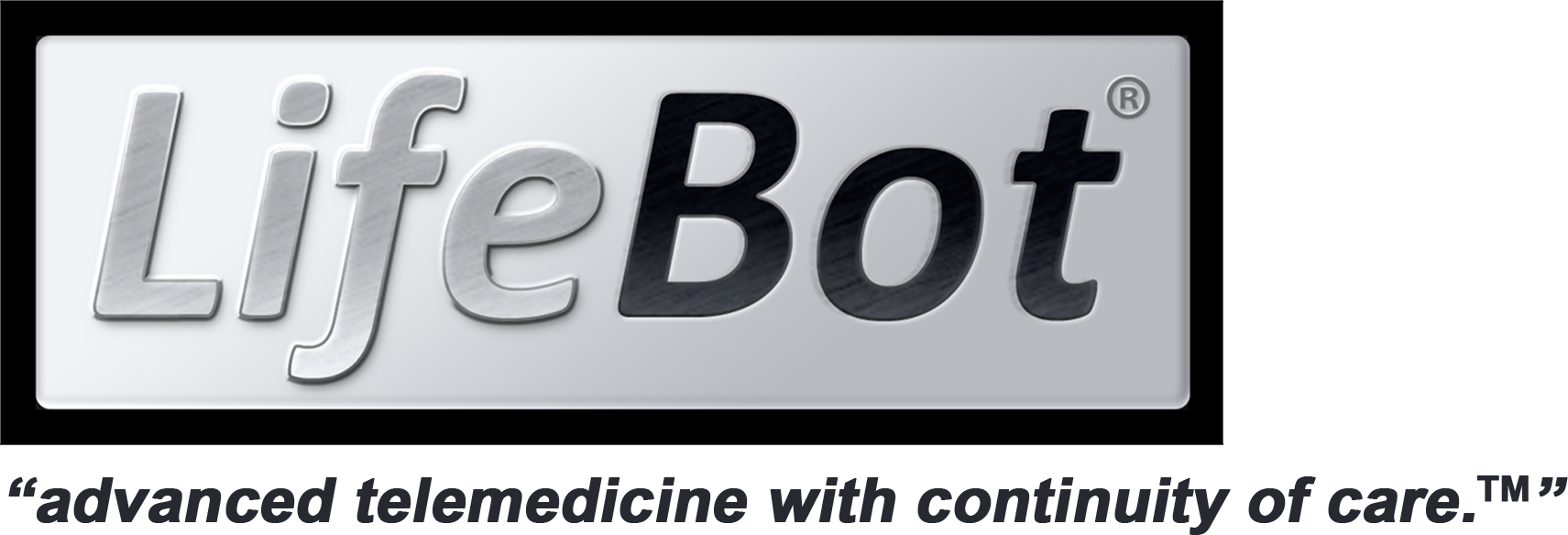
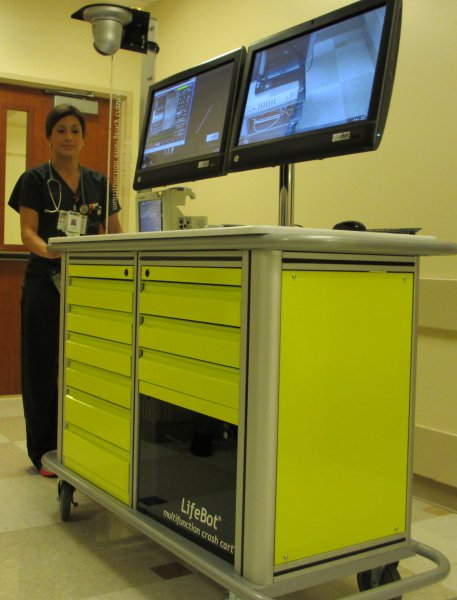
Important:
I. “Multi-Function” to Save Both Money-Budgets and Lives.
A mobile telemedicine cart should be versatile enough to handle routine day-to-day procedures but capable enough to manage unexpected emergencies as well. One should not have to purchase multiple carts to fit multiple needs. One cart should “do-it-all“.. it should be an “all-in-one” solution.
II. The First “Virtual Ambulance™”.
Now with the world’s most advanced Emergency Crash Cart, hospital Crash Cart Teams may deploy a cart where specialists may respond in seconds no matter where they are. They may simply login remotely to the cart system to be “virtually” on-the-scene.
III.The Right-Size Robot Cart.
Dual-Bay Telemedicine Robot Cart:
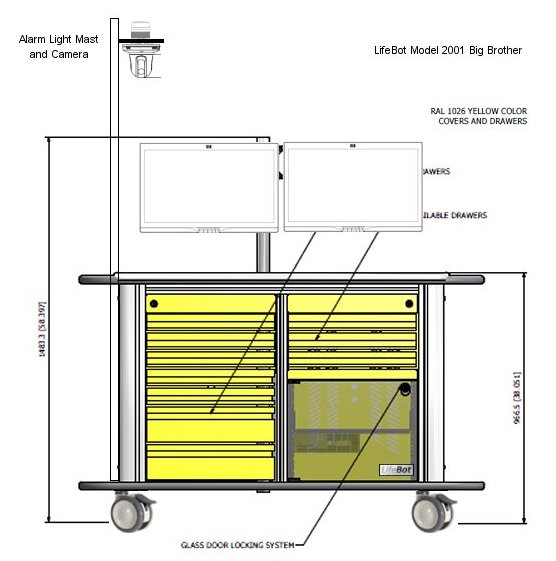
The Dual-Bay LifeBot Crash Cart is intended for use in major trauma rooms and wide-spread general floor use. It contains separate locking storage spaces for general telemedicine and emergency supplies.
Single-Bay Telemedicine Robot Cart:
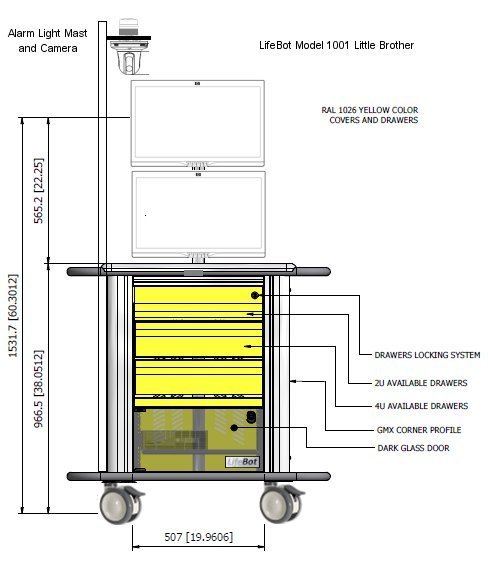
The Single-Bay LifeBot Crash Cart is made smaller to fit into more restrictive clinical environments and at reduced costs.
The LifeBot® Multi-Function Telemedicine Crash Cart

The LifeBot Cart has a flashing light system that clears the hallway in much the same way an ambulance clears the street for emergencies.
Real-Time Physician TelePresence Redefined.
Physicians, intensivists, tele-nurses, or any specialist may use LifeBot lightweight tablet or desktop PCs to login to carts for instant remote “tele-presence”. The same PCs may be used to login and be “virtually” on-the-scene to LifeBot equipped ambulances as well. view more..
Exclusive Telemedicine Technologies Developed with the U.S. Military.
LifeBot mobile telemedicine carts are the first and only carts designed to transmit “live” voice, video and full patient physiological data. This is the data usually acquired by complete physiological monitoring systems that are connected directly to the patient. Such parameters include ECG, Pulse Ox, NIBP, Invasive BP, and much much more. LifeBot carts utilize DREAMS™ technologies developed with the U.S. Military making them the most advanced in the world. view more..
The DREAMS™ system was conceived by renowned trauma surgeon James “Red” Duke, Jr. Dr. Duke and S. Ward Cassells, M.D, former Assistant Secretary of Defense (Medical Affairs, received the General Maxwell Thurman Award for these designs at the national meeting of the American Telemedicine Association.
Unique and Exclusive Robot Cart Features:
- All-in-One Multi-function, one cart may be utilized for all major purposes reducing overall costs, as opposed to cobbling together many different carts and solutions.
- DREAMS™ Technologies developed with U.S. Military…only telemedicine cart system to transmit complete critical patient physiological patient monitoring data live. view more..
- Over-Sight™ Acrylic Etched Steel Reinforced Camera Mast enables high-level patient observation over cart operators and provides for convenient mounting of multiple equipment and accessories.
- Protected Electronics: All computing, processing, recording, UPS, electronics securely protected in standard internal rack mounting systems.
- Security Locking System is designed to securely store and make ready everything one needs for an emergency including MEDS(drugs) and routine use exam cameras, etc. (preconnected and ready).
- Virtual Ambulance Mast Tower also houses a flashing digital lights and alarm system to clear the hallways in much the same way an ambulance clears the streets in route for an emergency.
- Includes patent pending “Boot While In-Route” system for emergency response.
- Accessories: Full line of exam cameras, ultrasound, portable cameras and choice of physiological monitoring systems.
- Optional Radio-Telephone: Voice-Over-IP (VOIP) digital communications for 700MHz P25, 800 MHz trunked, UHF, VHF, TETRA, and Standard Phone/PSTN systems to talk to in-bound and out-bound air and ground pre-hospital ambulance services.
- Six Inch medical industrial grade shock absorbing caster system with select locking mechanisms.
- Extra Storage: More secure storage space than any cart in the business.
- Optional Oxygen E-Cylinder mount bracket and CPR Backboard with side mounting system also available.
- Physician, invensivists, and emergency specialists LifeBot Tablet and Desktop PCS available separately.
Community Paramedicine Guide:
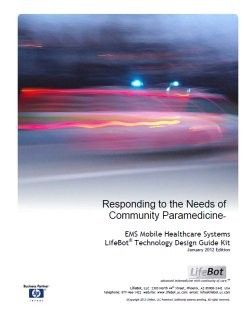
Multi-Function Crash Carts can be used for delivering primary care via EMS providers, remote clinics and satellite and outpatient facilities. The guide also is a detailed presentation on EMS Telemedicine combined with crucial Decision Support Software (DSS) and the prospects for using these technologies for substantially reducing healthcare costs.
Video-Conferencing
is NOT Telemedicine.
If one looks at the prominent telemedicine cart suppliers today, you may be shocked to find out most have little or no experience in the healthcare field at all; little knowledge of medical devices and acquiring critical life-saving physiologic information. Most are dedicated to performing video teleconferencing only and have a history as only audio visual specialists. view more..
The “Robotics” Element
The LifeBot robotic telemedicine crash cart system has numerous automated features so one may worry less about operating the cart system and more about the quality of patient care.
Physicians utilizing the LifeBot Slate tablet or Desktop PCs, for example, have remote control of the pan, tilt, zoom cameras next to the patient. This is just one of the many features of the LifeBot® DREAMS™ telemedicine systems. view more..
Applications:
- General Telemedicine: Deploy for all general telemedicine applications.
- Community Paramedicine: Deploy for delivery of primary care by nurse practitioners and qualified paramedics.
- Tele-Stroke: To meet American Heart and Stroke Hub and Spoke Network designs.
- STEMI 12-Lead ECG: To meet American Heart recommendations for interventional cardiology.
- Tele-Trauma: Live telemedicine support for advanced support by trauma surgeons in life-saving procedures.
- Tele-Psychiatry: Demonstrate savings using remote telemedicine for psychiatric support.
Remote Locations:
- Emergency Department: Deploy for tele-stroke, tele-trauma, tele-psychiatry, etc. and resuscitation support.
- General Floors: Deploy as advanced telemedicine crash carts on all general floors for critical support.
- Remote Hospitals and Clinics: Deploy where clinical specialists are needed.
- Corrections Prisons Jails: Deploy to save millions by eliminating high security transports.
- Schools and Universities: Deploy to support school nurses. Schools are staging areas for emergencies and disasters support.
- Nursing Home Extended Care: Deploy to support extended care nursing with full telemedicine support.
- Off-Shore and Sea-Going: Deploy in off-shore drilling and ocean going vessels.
- view more applications..
